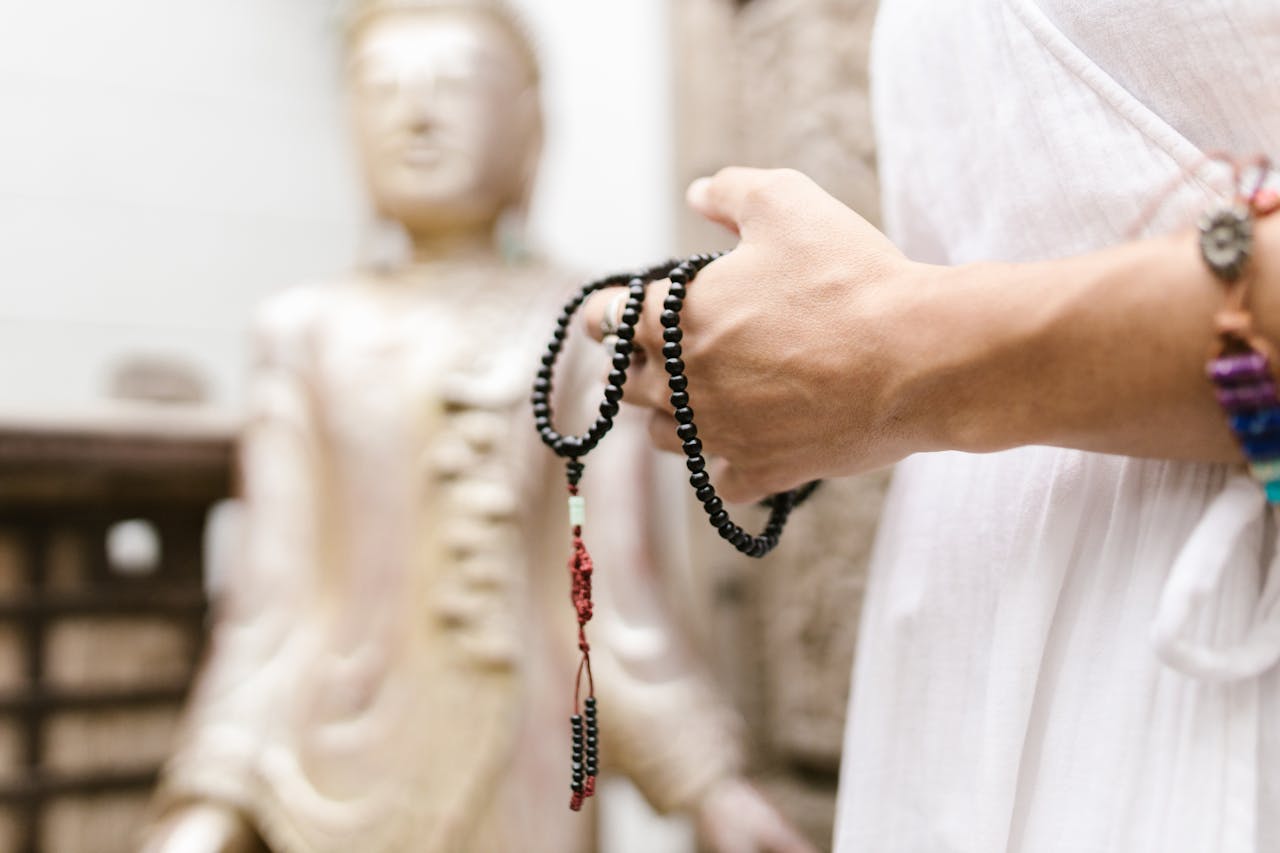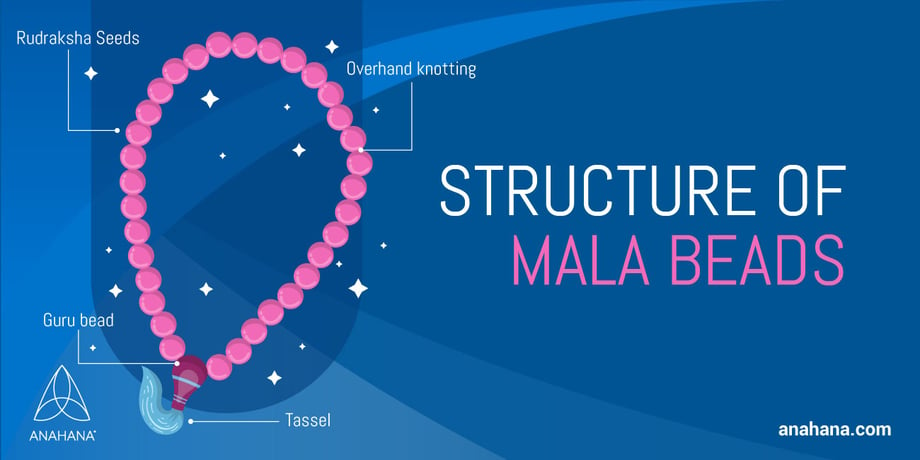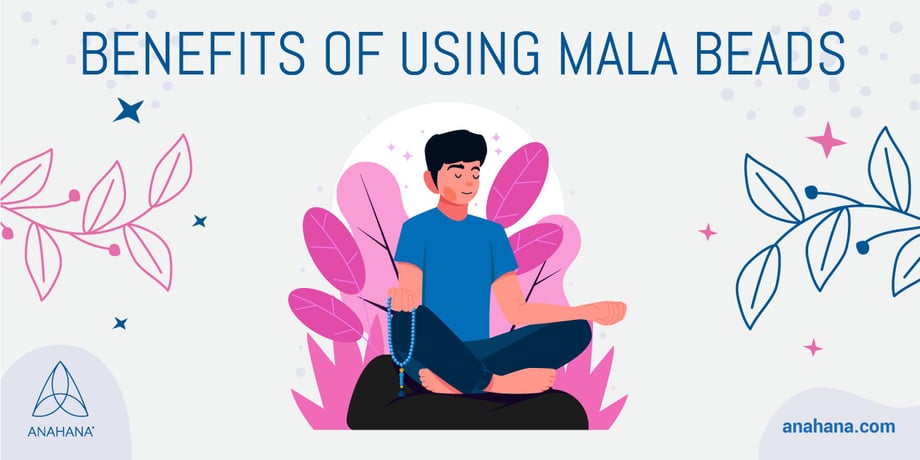
Table of Contents
Learn about the significance, history, uses, and benefits of the Mala beads, which practices use them, and how they can support your spiritual practice.
Mala Beads Explained
The word mala comes from Sanskrit for “garland.” Mala beads, also known as Jaap mala, are a loop of crafted prayer beads used in various Indian religions, including Buddhism, Sikhism, Hinduism, and Jainism, for recitations, prayers, or chanting mantras.
One may use them for mindfulness without any religious or spiritual affiliation purpose. For example, a mala necklace usually includes 108 beads, with the largest bead in the center, called the Guru bead, which is not for counting.
Mala beads may be made of various materials, such as seeds, bone, wood, stone, and other synthetic materials. Certain religions prefer one material over another depending on its usage and purpose.
More recently, people have utilized mala beads for various meditations due to their spiritual meaning. Many forms of mala beads exist, including mala necklaces, bracelets, and other types of jewelry.
Origin
While the specific origin of mala beads is unknown, mala beads were an integral part of many ancient cultures. Individuals believe that the practice originated in some part of India and spread from India to other Eastern countries.
The first literary reference to mala beads comes from a Mahayana text translated into Chinese during the 4th-5th century CE, and the story in China was associated with the monastic practice.
Malas were regarded as a common piece worn by monks during the era. There are a few pre-Song dynasty depictions of the mala beads. However, this might be due to their use in private religious practices, as Chinese authors often criticized monks who recited mantras in public.
Depictions of Qing Dynasty court officials during the Ming Dynasty showed mala beads associated with wealth, status, and an indication of spirituality.
Structure of Mala Beads

There are varying explanations as to why the mala beads contain 108 beads. 108 is an auspicious number and carries religious significance in Buddhist, Hindu, and Jain traditions. In some religions, they believe that individuals have 108 afflictions, or it is the number of possible phenomena or dharmas. The number has been consistent since mala beads have been incorporated into practice.
The 109th bead is the Guru bead which is for counting. Three smaller or distinctive beads are placed with the guru bead, dividing the mala beads into four sections of 27.
Division of the mala beads allows for fast estimation when a fraction of a single round is complete. The additional beads raise the number of mala beads to 111 (excluding the guru bead).
How to Use Mala Beads
One may use Mala beads in many ways during meditation, but mantra repetition and brain control are the most common uses.
One can use Mala beads to control breath utilizing a series of steps. The loop is held in the right hand and draped over the index finger, usually in Hindu practice, while Buddhists often use their left hand. The right thumb of the first bead, besides the guru bead, holds it in place while an individual completes one full breath (inhalation and exhalation).
With each breath, the fingers move to the next bead to advance the loop. To complete 108 breaths, individuals must finish at the guru bead. To begin counting the next round of breathing, one should move their fingers in the opposite direction until the guru bead is reached again.
Controlling Breath
Various cultures and practitioners use mala beads differently. For example, draping the loop over the second finger with the third and fourth fingers inside the loop and moving the beads toward the thumb using the index finger.
This movement symbolizes the atma (the index finger) going towards the Paramatma (thumb) by overcoming the material world (represented by the other three fingers).
Repeating Mantras
Similarly, individuals may use mala beads to repeat and chant "Japa," also known as mantras. Reciting mantras allows individuals to focus and become more self-aware.
Om is a common mantra recited on the mala beads. Individuals can say the mantra out loud or repeat them in their heads.
Use of Mala Beads in Various Religions
A variety of materials are used to make mala beads. Religious groups, particularly Hindu Tantra and Vajrayana Buddhism, favor different materials based on the intended spiritual practice the mala beads are used for.
Buddhism
Materials used in Buddhism include pearl, crystal, macre, or other materials that are white or clear in color to purify themselves. They may use copper, lotus, gold, and silver beads to count mantras to increase merit, knowledge, and lifespan.
Beads consisting of saffron, ground sandalwood, or other fragrant substances help individuals tame others, and mala beads composed of human bones and rudraksha aim to subdue afflictions or malicious spirits.
Beads of bodhi wood have various purposes, including counting different mantras, circumambulation, prayers, and prostration.
Hinduism
Mala beads in Hinduism are usually made up of fruit stones from the rudraksha or wood from the tulsi plant, as they are considered sacred. Hindu mala is generally made using a small knot tied between each bead.
Benefits of Using Mala Beads

The widespread belief was that only the most devoted practitioners could experience enlightenment. Today, there are several benefits of using mala beads for mindfulness and meditation that extend beyond religious purposes.
Mala beads can reduce stress and pain, lower blood pressure and heart rate, calm the nervous system, improve sleep, and enhance memory and focus.
Mala beads help ease symptoms of anxiety, depression, pain, and other psychological problems in individuals.
Mala Beads in Yoga Practice and Meditation
One can use Mala Bead in mindfulness and spiritual practice, including yoga and meditation. More recently, mala beads have been utilized for yoga and meditation worldwide because they have a deep connection to opening the mind to spirituality and mental grounding.
Mala beads can help individuals recite or chant mantras during meditation that connect them to their deeper inner self, managing their attention span and emotions.
Carrying and Storing Mala Beads
Mala can be carried and stored by practitioners in different ways. For example, individuals can wrap mala beads to fit on the wrist as a bracelet; mala beads can be worn as necklaces or suspended from a belt.
One can carry Mala beads in small pouches where they can be removed from before use. They can be carried in larger pouches hanging from the back of the hand, allowing individuals to use the mala without it being visible to the public view or preventing it from contact with the ground.
At home, one could store Mala beads with or without a pouch. One can store Mala beads in containers or jewelry boxes. Individuals with shrines or altars in their homes can also keep the mala beads on the altars when they are not using the mala beads.
Choosing the Right Mala Beads
Each type of mala bead carries its intention and significance. Choices and preferences of mala beads, including their size and materials, differ based on individual needs and preferences.
Mala beads for protection
Some common mala beads include mala beads for protection, balance, strength, clarity, and confidence. The most common type of mala bead for protection is the turquoise bead. Turquoise produces healing effects on the mind, body, and soul and serves as a shield to protect individuals and purify the mind and body from negative energies.
Mala beads for balance and strength
One may use Mala gemstones with Jasper to introduce and achieve a sense of balance in life. The Jasper mala beads can also be combined with reciting suggestive mantras.
The lava stone is used in mala beads for strength when faced with difficult situations and for individuals seeking resilience and strength.
Mala beads for clarity and confidence
Individuals seeking peace of mind and clarity can utilize a mala made of clear gemstone quartz to align themselves with their Crown chakra or seat of the higher self.
Moreover, individuals seeking to boost confidence should use mala beads of blue opal. Finally, the stone connects to the Throat chakra, allowing individuals to find their voice and speak confidently and clearly.
The type of mala beads one uses will depend on the material and purpose of the stone that makes up the mala. Various sites sell materials and beads for the mala.
Creating Your Own Mala Beads
Introduction to Handcrafting Mala Beads: Embrace the tradition of crafting your own malas, a meditative and mindful process. This practice connects you to the ancient traditions and the significance of each bead strung.
Materials and Bead Selection: Choose materials that resonate with your spiritual intentions. Woods, gemstones, and seeds each hold unique energies. Select beads that align with your yoga or chakra meditation practice, infusing your mala with personal meaning.
Steps in Crafting a Mala: Begin by selecting 108 beads, representing an auspicious number in many spiritual practices. The largest bead, the guru bead, serves as a starting and ending point. String each bead with care and focus, reflecting on your intentions with each addition.
Infusing Your Mala with Intention: As you craft your mala, take extra care setting an intention for your spiritual journey. Whether it's for enhancing meditation focus, promoting well-being, or connecting with your higher self, let this intention guide your creation.
Conclusion: Crafting your own mala beads is more than just an activity; it's a journey towards deeper spiritual connection and mindfulness. Your handmade mala will not only support your meditation and yoga practices but also serve as a personal amulet infused with your intentions and energies.
Conclusion
Mala beads are not only used for seasoned yogis but can also be used by beginners to start practicing yoga and meditation and to improve their spiritual and mental health.
Beginning mindfulness early using meditation and mala beads can have long-term benefits for individuals and be an effective supplement to an individual’s journey to one’s higher self.
Using mala beads to chant mantras help individuals improve and focus their attention. Specific mala beads aim to make the practice easier.
Choosing the right mala beads, including the materials and styles, will allow individuals to pick the ones suitable for their purpose.
References
What Are Mala Beads, How to Use Them, and The Best Ones to Buy - The Yoga Nomads
How to Use Mala Beads For Meditation
Choosing Your Mala Beads In-Depth Guide
Disclaimer
The contents of this article are provided for informational purposes only and are not intended to substitute for professional medical advice, diagnosis, or treatment. It is always recommended to consult with a qualified healthcare provider before making any health-related changes or if you have any questions or concerns about your health. Anahana is not liable for any errors, omissions, or consequences that may occur from using the information provided.

By: Meriah McCauley
Meriah McCauley is passionate about the art and science of holistic health and healing. She explored the power of yoga through working with her mentor and guru Dr. Don Stapleton in Costa Rica. She also received a Masters in Psychology from Columbia University, specializing in Spirituality and the MindBody connection. Meriah now offers coaching, yoga teacher trainings, and Holotropic Breathwork for personal development. She loves to connect with those on this path.
